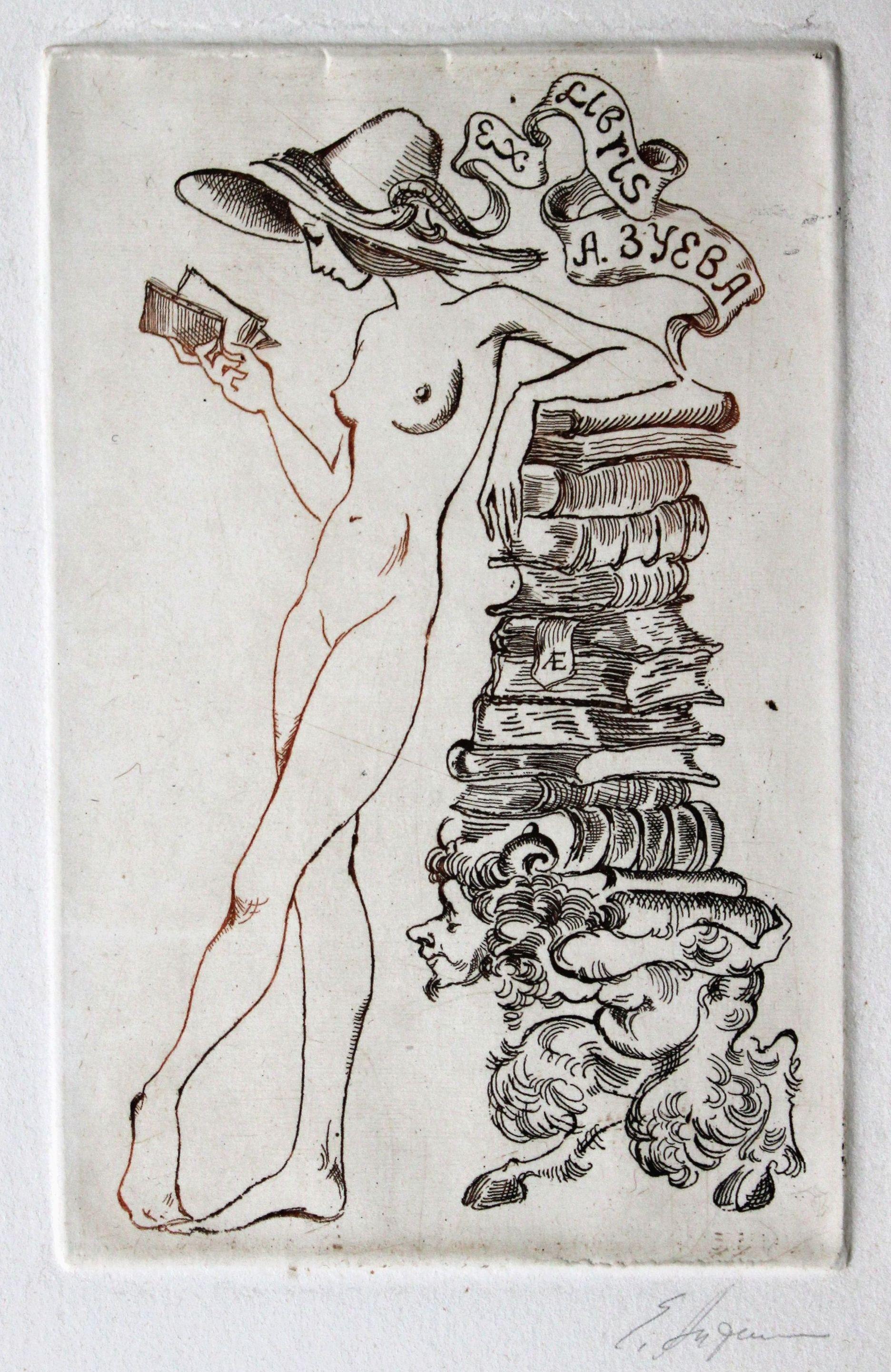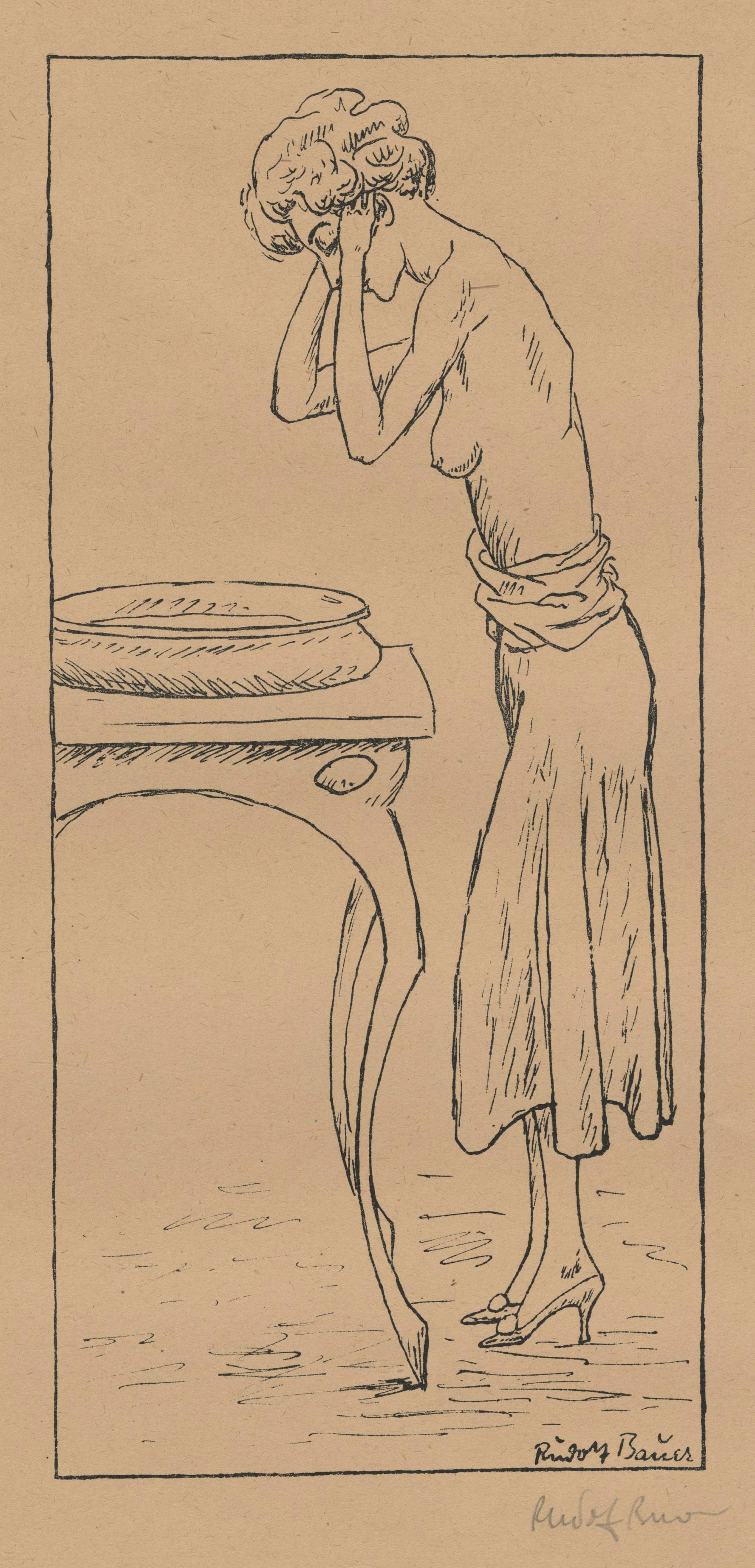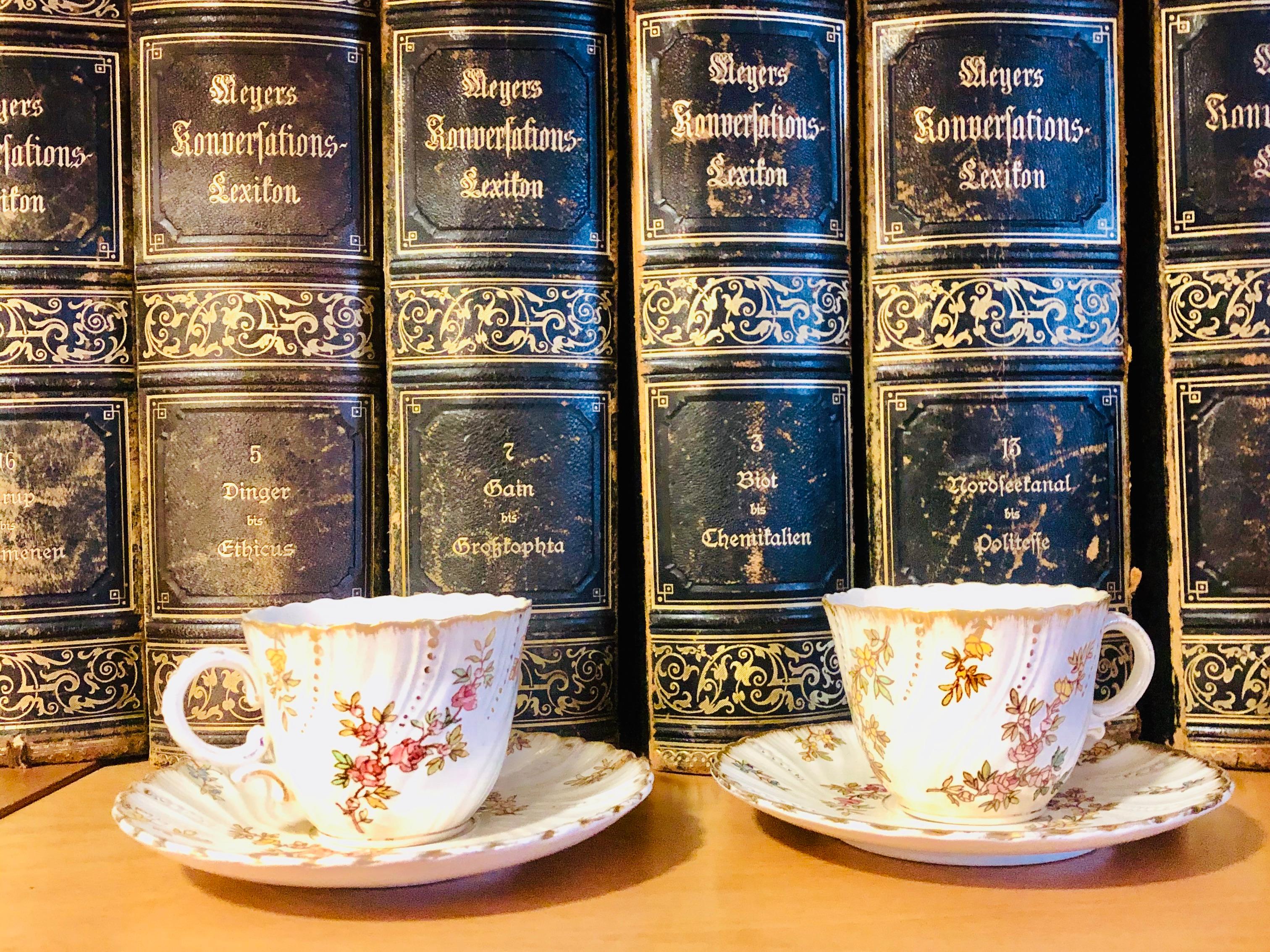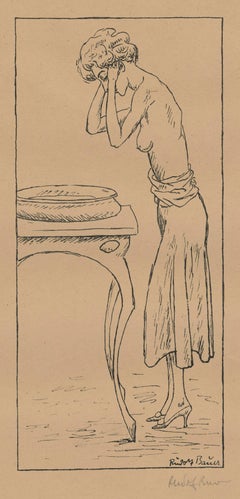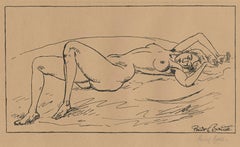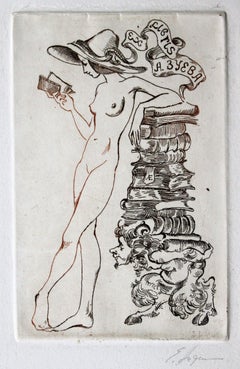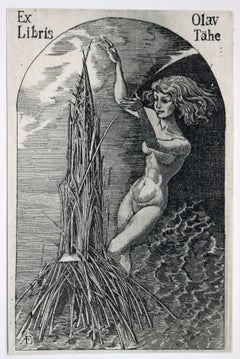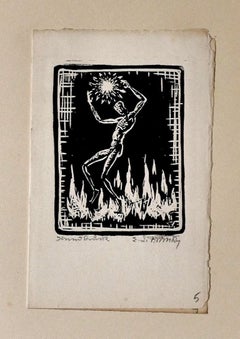Jugendstil Prints and Multiples
to
3
11
6
12
5
10
2
2
3
Overall Height
to
Overall Width
to
20,011
17,941
11,504
6,241
4,671
2,620
1,318
1,252
1,030
943
642
502
276
198
10
8
4
3
3
2
2
2
2
2
2
2
1
1
1
1
1
1
1
1
3
13
1
5
3
1
3
2
1
1
1
1
8
6
4
2
2
Style: Jugendstil
untitled (Young Woman Washing)
By Rudolf Bauer
Located in Fairlawn, OH
untitled (Young Woman Washing)
Lithograph, c. 1910
Signed in pencil lower right; signed in the plate lower right (see photo)
Image size: 11 x 5-1/8"
Sheet size: 18 7/8 x 12 5/8 inches
Condition: Very good
Aging to the tan paper it is printed on
Provenance: Estate of the Artist
Borghi & Company, NYC
Rudolph Bauer
1889-1953
Rudolf Bauer was born in Lindenwald near Bromberg, Silesia, in 1889 but his family moved only a few years later to Berlin. In 1905 Bauer began his studies at the Berlin Academy of Art but left the Academy only a few months later to educate himself. The upshot was paintings, caricatures and comical drawings which were published in 'Berliner Tageblatt', 'Ulk' and 'Le Figaro'.
From 1912 Bauer contributed to the magazine and Gallery 'Der Sturm' founded by Herwarth Walden and pivotal to German Expressionism and the international avant-garde. In 1915 Rudolf Bauer participated for the first time in a group show at Walden's gallery. There he met Hilla von Rebay, with whom he began a relationship of many years that was crucial to Bauer's later work. By 1922 Bauer had shown work at about eight exhibitions mounted by 'Der Sturm'. From 1918 he also taught at the 'Der Sturm' art school, where Georg Muche was the director. After the war ended, Bauer was a founding member of the 'November Group' although he did not collaborate closely with the group. In 1919 Bauer joined forces with the painter and architect Otto Nebel and with Hilla von Rebay to found the artists' association 'Die Krater'. Impressionist at the outset, Bauer's early work reveals Cubist and Expressionist influences. By 1915/16 Bauer had switched to an abstract pictorial idiom, which is markedly influenced by Kandinsky. In the early 1920s Bauer was also preoccupied with Russian Constructivism as well as the Dutch de Stijl group. Bauer's decided preference for non-representational painting culminated in 1929 with the foundation of a private museum, 'Das Geistreich', which he directed as a salon for abstract art.
Political developments in Germany forced Bauer to sell some of his work in America from 1932. His agent in America was Hilla von Rebay, who was by now director of the Guggenheim Collection. In 1936 she organized a touring exhibition of non-representational European art that included sixty Rudolf Bauer oil...
Category
1910s Jugendstil Prints and Multiples
Materials
Lithograph
Reclining Nude on Bed
By Rudolf Bauer
Located in Fairlawn, OH
Reclining Nude on Bed
Lithograph, c. 1910
Signed in pencil lower right and in the plate, lower right
Image size: 7-1/4 x 13"
Sheet size: 12 1/2 x 19 inches
Condition: very good
Some aging to the tan paper
Provenance: Estate of the Artist
Borghi & Company, New York
Rudolph Bauer
1889-1953
Rudolf Bauer was born in Lindenwald near Bromberg, Silesia, in 1889 but his family moved only a few years later to Berlin. In 1905 Bauer began his studies at the Berlin Academy of Art but left the Academy only a few months later to educate himself. The upshot was paintings, caricatures and comical drawings which were published in 'Berliner Tageblatt', 'Ulk' and 'Le Figaro'.
From 1912 Bauer contributed to the magazine and Gallery 'Der Sturm' founded by Herwarth Walden and pivotal to German Expressionism and the international avant-garde. In 1915 Rudolf Bauer participated for the first time in a group show at Walden's gallery. There he met Hilla von Rebay, with whom he began a relationship of many years that was crucial to Bauer's later work. By 1922 Bauer had shown work at about eight exhibitions mounted by 'Der Sturm'. From 1918 he also taught at the 'Der Sturm' art school, where Georg Muche was the director. After the war ended, Bauer was a founding member of the 'November Group' although he did not collaborate closely with the group. In 1919 Bauer joined forces with the painter and architect Otto Nebel and with Hilla von Rebay to found the artists' association 'Die Krater'. Impressionist at the outset, Bauer's early work reveals Cubist and Expressionist influences. By 1915/16 Bauer had switched to an abstract pictorial idiom, which is markedly influenced by Kandinsky. In the early 1920s Bauer was also preoccupied with Russian Constructivism as well as the Dutch de Stijl group. Bauer's decided preference for non-representational painting culminated in 1929 with the foundation of a private museum, 'Das Geistreich', which he directed as a salon for abstract art.
Political developments in Germany forced Bauer to sell some of his work in America from 1932. His agent in America was Hilla von Rebay, who was by now director of the Guggenheim Collection. In 1936 she organized a touring exhibition of non-representational European art that included sixty Rudolf Bauer oil...
Category
1910s Jugendstil Prints and Multiples
Materials
Lithograph
Original Antique Advertising Poster Wroclaw Festival Week Breslauer Festwoche
Located in London, GB
Original antique advertising poster for the Breslauer Festwoche Sport Spiel Kunst Festwiese im Scheitniger Park / Wroclaw Festival Week Sport Games Art Fairground in the Szczytnicki ...
Category
1910s Jugendstil Prints and Multiples
Materials
Paper
Ex Libris. Paper, etching, 11x7 cm
Located in Riga, LV
Ex Libris A. Zuyeva
Paper, etching, 11x7 cm
Category
1990s Jugendstil Prints and Multiples
Materials
Etching, Paper
Ex libris. Paper, woodcut, 11x7cm
Located in Riga, LV
Ex libris Olav Tähe
Paper, woodcut, 11x7cm
Category
1990s Jugendstil Prints and Multiples
Materials
Woodcut, Paper
Three graces. Paper, etching, 12x11cm
Located in Riga, LV
Three graces. Paper, etching, 12x11cm
Category
1990s Jugendstil Prints and Multiples
Materials
Etching, Paper
Woman's Head (Vrouwekop), Marguerite Adolphine Helfrich
By Jan Toorop
Located in Fairlawn, OH
Woman's Head (Vrouwekop), Marguerite Adolphine Helfrich
Drypoint, 1897
Signed lower right in pencil: J Toorop; by later hand
Toorop's model for this print was Marguerite Adolphine H...
Category
1890s Jugendstil Prints and Multiples
Materials
Drypoint
Troubadour, from The Mastersingers of Nuremberg
Located in Middletown, NY
Stipple point etching on tissue-thin handmade Japon paper, 7 5/8 x 5 inches (193 x 126 mm), full margins. Signed, titled, dated, inscribed and numbered 10/25 in pencil, lower margin....
Category
Early 20th Century Jugendstil Prints and Multiples
Materials
Handmade Paper, Etching
School Girls of Vienna Packing Rations from England and America for the Children
Located in Fairlawn, OH
School Girls of Vienna Packing Rations from England and America for the Little Children
Color lithograph poster, 1921
Signed lower right in the text (see photo)
Created in the Wein (Vienna), School of Arts and Crafts
Designed by Stephanie Krauss, aged 15 years
Published by the American Red Cross...
Category
1920s Jugendstil Prints and Multiples
Materials
Lithograph
Poster for the Saxon Trade and Art Exhibition, Dresden 1896
Located in Fairlawn, OH
Poster for the Saxon Trade and Art Exhibition, Dresden 1896
Color lithograph poster mounted on heavy linen, 1896
Signed in the stone lower left corner (see photo)
Proof before additi...
Category
1890s Jugendstil Prints and Multiples
Materials
Lithograph
Von Der Pflanze Zum Ornament
Located in Wilton, CT
30 plates of floral designs from the Jugendstil period
Category
Early 1900s Jugendstil Prints and Multiples
Materials
Lithograph
Blue and White Embroidery Design
By Felix Fuzier
Located in New York, NY
Original color Jugendstil design lithograph from "Dessins et Broderies Pour Costum et Ameublement." Paris, 1900.
Category
Early 1900s Jugendstil Prints and Multiples
Materials
Paper
Tea Time Photography Print Limited Edition Signed
Located in Slovak Republic, SK
Print. Limited edition 15. Signed by the author.
Category
21st Century and Contemporary Jugendstil Prints and Multiples
Materials
Digital, Color
Blue and White Embroidery Design
By Felix Fuzier
Located in New York, NY
Original color Jugendstil design lithograph from "Dessins et Broderies Pour Costum et Ameublement." Paris, 1900.
Category
Early 1900s Jugendstil Prints and Multiples
Materials
Paper
Original Antique Poster For A Dinner Concert At The Savoy Bar Munchen / Munich
Located in London, GB
Original antique poster for a dinner concert at the Savoy Bar in Munich depicting two men in smart evening suits looking at a piece of paper, the seated gentleman wearing a monocle e...
Category
Early 1900s Jugendstil Prints and Multiples
Materials
Paper
Dornröschen (Sleeping Beauty.)
By Heinrich Vogeler
Located in Storrs, CT
Reif 20.IIc(of e). 10 5/8 x 9 3/4 (sheet 19 X 12 3/4). Slight scattered foxing in the margins, away from the image. A rich, tonal impression printed on sturdy wove paper. Proof aside...
Category
Late 19th Century Jugendstil Prints and Multiples
Materials
Fiberglass, Drypoint, Etching, Aquatint
Wilhelm/Mozer/Munchen-Nord/Adalbertstr. 31A/Telefon 1939 /Delikatessen.
Located in New York, NY
Vintage Poster for the Wilhelm/Mozer Delikatessen.
Ref:Das fruhe Plakat 1357 Ludwig Holhwein.Plakate der Jahne 1906-40 Tavel VI Kat Nr. 23.
Hohlwein began his career as graphic d...
Category
Early 1900s Jugendstil Prints and Multiples
Materials
Lithograph
Related Items
The Bath of Venus - Original lithograph and watercolor
By Joseph Felon
Located in Paris, FR
Joseph FELON (1818 - 1897)
The Bath of Venus
Original stone lithograph, enhanced with watercolor
Printed signature in the plate
On vellum 28 x 44 cm (c. 11 x 18 inch)
Excellent con...
Category
Late 19th Century Jugendstil Prints and Multiples
Materials
Lithograph, Watercolor
Fire - Original Woodcut on Paper by Erika Lawson Frimke - 1937
Located in Roma, IT
Fire is an original woodcut artwork on paper realized in 1937 ca. by Russian artist Erika Lawson Frimke( 1878-1956), Hand-signed on the lower right in pencil.
The state of preservat...
Category
1930s Jugendstil Prints and Multiples
Materials
Woodcut
H 3.15 in W 2.56 in D 0.04 in
Erotic Scene - Woodcut by Mino Maccari - 1944
By Mino Maccari
Located in Roma, IT
Erotic Scene is an original xilography artwork realized by Mino Maccari in 1944. Hand-signed in the pseudonym of "Jean Baschie" which is the artist's signature in 1944 erotic series artwork...
Category
1940s Jugendstil Prints and Multiples
Materials
Woodcut
Shunga - Woodcut by Katsukawa Schuncho - Mid-18th Century
Located in Roma, IT
Shunga is an original modern artwork realized by Katsukawa Schuncho (1726 – 1793) in the half of the 18th Century.
Oban yokoe.
Erotic scene from the series "Koshuko zue juni ko" (Erotic pictures...
Category
1750s Jugendstil Prints and Multiples
Materials
Woodcut, Paper
H 9.85 in W 11.82 in D 0.04 in
Seishi Ai-oi Genji – Set of 12 Shunga works together w/astrological commentary
Located in Middletown, NY
Set of 12 woodblock prints in colors on handmade, laid mulberry paper, 6 3/4 x 10 1/4 inches (170 x 258 mm), printed in Ka-ei 4 (1851). Each print with minor handling wear, otherwise in excellent condition with bright and fresh color, and with details printed in silver ink. The images themselves contain several illusive characters indicating the publisher which are obfuscated by figures, as intended. Presented loose, as issued. A fine set.
The astrological commentary print has a large and meandering blind stamp with a bird and palm frond motif. This print lists various phrases concerning the Twelve Zodiac Animals as historically counted in Japan, and appears to include erotic commentary on the traits of people born under each of the twelve signs.
These Shunga images were issued in books that paralleled (in an erotic fashion...
Category
Mid-19th Century Jugendstil Prints and Multiples
Materials
Handmade Paper, Ink, Woodcut
Henri Matisse – Le Repos du modèle - hand-signed lithograph - 1922
Located in Varese, IT
HENRI MATISSE (1869-1954)
Le Repos du modèle
lithograph, on Japanese paper, 1922, Duthuit’s first state (of two), signed in pencil by artist, one of 85 signed impressions from a plan...
Category
1920s Jugendstil Prints and Multiples
Materials
Lithograph, Paper
Leon Bakst Three Costume designs from Le Dieu Bleu Ballet 1911
By Leon Bakst
Located in Paonia, CO
Three iconic Leon Bakst costume designs for Le Dieu Bleu ( The Blue God ) a ballet choreographed by Michel Fokine and written by Cocteau. The ballet premiered in Paris in 1...
Category
20th Century Jugendstil Prints and Multiples
Materials
Color
Alfons Mucha - Original Lithograph - Femmes Art Nouveau
Located in Collonge Bellerive, Geneve, CH
Title: Decorative Documents
Author: Alfons Mucha.
Publisher: Paris: Librairie Centrale des Beaux-Arts, 13 Rue Lafayette. Emile Levy publisher. Published ...
Category
Early 1900s Jugendstil Prints and Multiples
Materials
Lithograph
H 17.33 in W 13.39 in D 0.04 in
Art Nouveau "Glasgow Rose" original lithograph by Charles Rennie Mackintosh
Located in Chicago, IL
Charles Rennie Mackintosh was a Scottish architect, designer, and visual artist. His artistic approach had much in common with European Symbolism. His work, alongside that of his wif...
Category
Early 1900s Jugendstil Prints and Multiples
Materials
Lithograph
"Lendas Africanas Da Bahia" from the suite.
Located in San Francisco, CA
This artwork titled " Lendas Africanas Da Bahia" from the suite, 1978, is an original colors woodcut by renown Brazilian/Argentinian artist Hector Julio Paride Barnabo Carybe, 1911-1997. It is hand signed and numbered 83/200 in pencil by the artist. The Wood block mark (image) is 23.65 x 15.75 inches, sheet size is 26.75 x 19 inches. It is in excellent condition, has never been framed. It will be shipped in a 8 inches diameter heavy duty tube.
About the artist:
Héctor Julio Páride Bernabó (7 February 1911 – 2 October 1997) was an Argentine-Brazilian artist, researcher, writer, historian and journalist. His nickname and artistic name, Carybé, a type of piranha, comes from his time in the scouts. He died of heart failure after the meeting of a candomblé community's lay board of directors, the Cruz Santa Opô Afonjá Society, of which he was a member.
Quick Facts Born, Died ...
Carybé
Born
Héctor Julio Páride Bernabó
7 February 1911
Lanús, Argentina
Died
2 October 1997 (aged 86)
Salvador, Bahia, Brazil
Nationality
Brazilian
Known for
Painter, engraver, draughtsman, illustrator, potter, sculptor, mural painter, researcher, historian and journalist
Close
He produced thousands of works, including paintings, drawings, sculptures and sketches. He was an Obá de Xangô, an honorary position at Ilê Axé Opô Afonjá.
Orixá Panels in the Afro-Brazilian Museum in Salvador
Some of Carybé's work can be found in the Afro-Brazilian Museum in Salvador: 27 cedar panels representing different orixás or divinities of the Afro-Brazilian religion candomblé. Each panel shows a divinity with their associated implements and animal. The work was commissioned by the former Banco da Bahia S.A., now Banco BBM S.A., which originally installed them in its branch on Avenida Sete de Setembro in 1968.
Murals at Miami International Airport
American Airlines, Odebrecht and the Miami-Dade Aviation Department partnered to install two of Carybé's murals at Miami International Airport. They have been displayed in the American Airlines terminal at John F. Kennedy International Airport in New York since 1960. The 16.5 x 53-foot murals were accredited when Carybé won the first and the second prize in a contest of public art pieces for JFK airport.
As its terminal at that airport was due for demolition, American Airlines donated the murals to Miami-Dade County, and Odebrecht invested in a project to remove, restore, transport and install the murals at Miami International Airport.
The mural "Rejoicing and Festival of the Americas" portrays colorful scenes from popular festivals throughout the Americas, and "Discovery and Settlement of the West" depicts the pioneers’ journey into the American West.
Carybé's Woodcuts in Gabriel García Márquez's Books
Carybé illustrated four books by the Colombian writer Gabriel García Márquez, including One Hundred Years of Solitude, The Autumn of the Patriarch, Chronicle of a Death Foretold, and Love in the Time of Cholera "Carybé: um mestre da cultura baiana". ArqBahia Arquitetura, design, arte e lifestyle (in Brazilian Portuguese). 26 April 2023.. In particular, the woodcuts in One Hundred Years of Solitude are well-known for providing a visual image of the fictional town of Macondo, where the story takes place. The illustrations depict the colorful and winding houses, the railway bridge, and the hot and humid climate of the region, contributing to the reader's immersion in the story.
Carybé's woodcuts are, therefore, an important part of Gabriel García Márquez's literary legacy, bringing a visual dimension to his stories that further enriches the reader's experience.
Timeline
1911 — Birth in Lanús, Argentina.
1919 — Moved to Brazil.
1921 — The name Carybé is first given to him by the Clube do Flamengo scouts group, in Rio de Janeiro.
1925 — Beginning of his artistic endeavours, going to the pottery workshop of his elder brother, Arnaldo Bernabó, in Rio de Janeiro.
1927–1929 — Studies at the National School of Fine Arts, in Rio de Janeiro.
1930 — Worked for the newspaper Noticias Gráficas, in Buenos Aires, Argentina.
1935–1936 — Works with the writer Julio Cortázar and as a draughtsman for the El Diario newspaper.
1938 — Sent to Salvador by newspaper Prégon.
1939 — First collective exhibition, with the artist Clemente Moreau, at the Buenos Aires City Museum of Fine Arts, Argentina; illustrates the book Macumba, Relatos de la Tierra Verde, by Bernardo Kardon, published by Tiempo Nuestro.
1940 — Illustrates the book Macunaíma, by Mário de Andrade.
1941 — Draws the Esso Almanach, the payment for which allows him to set on a long journey through Uruguay, Brazil, Bolivia, and Argentina.
1941–1942 — Study trip around several South American countries.
1942 — Illustration for the book La Carreta by Henrique Amorim, published by El Ateneo (Buenos Aires, Argentina).
1943 — Together with Raul Brié, translates the book Macunaíma, by Mário de Andrade, into Spanish; produces the illustrations for the works Maracatu, Motivos Típicos y Carnavalescos, by Newton Freitas, published by Pigmaleon, Luna Muerta, by Manoel Castilla, published by Schapire, and Amores de Juventud, by Casanova Callabero; also publishes and illustrates Me voy al Norte, for the quarterly magazine Libertad Creadora; awarded First Prize by the Cámara Argentina del Libro (Argentine Book Council) for the illustration of the book Juvenília, by Miguel Cané (Buenos Aires, Argentina).
1944 — Illustrates the books The Complete Poetry of Walt Whitmann and A Cabana do Pai Tomás, both published by Schapire ; as well as and Los Quatro Gigantes del Alma by Mira y Lopez, Salvador BA; attends capoeira classes, visits candomblé meetings and makes drawings and paintings.
1945 — Does the illustrations for Daniel Defoe's Robinson Crusoe, for the Viau publishing house.
1946 — Helps in setting up the Tribuna da Imprensa newspaper, in Rio de Janeiro.
1947 — Works for the O Diário Carioca newspaper, in Rio de Janeiro.
1948 — Produces texts and illustrations for the book Ajtuss, Ediciones Botella al Mar (Buenos Aires, Argentina).
1949–1950 — Invited by Carlos Lacerda to work at the Tribuna da Imprensa, in Rio de Janeiro.
1950 — Invited by the Education Secretary Anísio Teixeira, moves to Bahia, and produces two panels for the Carneiro Ribeiro Education Center (Park School), in Salvador, Bahia.
1950–1997 — Settles in Salvador, Bahia.
1950–1960 — Actively participate in the plastic arts renewal movement, alongside Mário Cravo Júnior, Genaro de Carvalho, and Jenner Augusto.
1951 — Produces texts and illustrations for the works of the Coleção Recôncavo, published by Tipografia Beneditina and illustrations for the book, Bahia, Imagens da Terra e do Povo, by Odorico Tavares, published by José Olímpio in Rio de Janeiro; for the latter work he receives the gold medal at the 1st Biennial of Books and Graphic Arts.
1952 — Makes roughly 1,600 drawings for the scenes of the movie O Cangaceiro, by Lima Barreto; also works as the art director and as an extra on the film (São Paulo, SP).
1953 — Illustrations for the book A Borboleta Amarela, by Rubem Braga, published by José Olímpio (Rio de Janeiro, RJ).
1955 — Illustrates the work O Torso da Baiana, edited by the Modern Art Museum of Bahia.
1957 — Produces etchings, with original designs, for the special edition of Mário de Andrade's Macunaíma, published by the Sociedade dos 100 Bibliófilos do Brasil.
1958 — Makes an oil painting mural for the Petrobras Office in New York, USA; illustrates the book As Três Mulheres de Xangô, by Zora Seljan, published by Editora G. R. D. (Rio de Janeiro, RJ); Receives a scholarship grant in New York, USA.
1959 — Takes part in the competition for the New York International Airport panels project, in New York, USA, winning first and second prizes.
1961 — Illustrates the book Jubiabá, by Jorge Amado, published by Martins Fontes (São Paulo, SP).
1963 — Awarded the title of Honorary Citizen of Salvador, Bahia.
1965 — Illustrates A Muito Leal e Heróica Cidade de São Sebastião do Rio de Janeiro, published by Raymundo Castro Maya (Rio de Janeiro, RJ).
1966 — With Jorge Amado, co-authors Bahia, Boa Terra Bahia, published by Image (Rio de Janeiro, RJ); writes and illustrates the book Olha o Boi, published by Cultrix (São Paulo, SP).
1967 — Receives the Odorico Tavares Prize – Best Plastic Artist of 1967, in a competition ran by the state government to stimulate the development of plastic arts in Bahia; makes the Orixás Panels for the Banco da Bahia (currently at the UFBA Afro-Brazilian Museum) (Salvador, BA).
1968 — Illustrates the books Carta de Pero Vaz de Caminha ao Rei Dom Manuel, published by Sabiá (Rio de Janeiro) and Capoeira Angolana, by Waldeloir Rego, published by Itapoã (Bahia).
1969 — Produces the illustrations for the book Ninguém Escreve ao Coronel, by Gabriel Garcia Marquez, published by Sabiá (Rio de Janeiro, RJ).
1970 — Illustrates the books O Enterro do Diabo and Os Funerais de Mamãe Grande, published by Sabiá (Rio de Janeiro, RJ), Agotimé her Legend, by Judith Gleason, published by Grossman Publishers (New York, USA).
1971 — Illustrates the books One Hundred Years of Solitude, by Gabriel Garcia Marquez and A Casa Verde by Mario Vargas Llosa, both published by Sabiá (Rio de Janeiro, RJ); produces texts and illustrations for the book Candomblé da Bahia, published by Brunner (São Paulo, SP).
1973 — Illustrations for Gabriel Garcia Marquez's A Incrível e Triste História de Cândida Erendira e sua Avó Desalmada (Rio de Janeiro, RJ); paints the mural for the Legislative Assembly and the panel for the Bahia State Secretary of the Treasury.
1974 — Produces woodcuts for the book Visitações da Bahia, published by Onile.
1976 — Illustrates the book O Gato Malhado e a Andorinha Sinhá: uma história de amor, by Jorge Amado (Salvador, BA); receives the title of Knight of the Order of Merit of Bahia.
1977 — Certified with the Honor for Afro-Brazilian Cult Spiritual Merit, Xangô das Pedrinhas ao Obá de Xangô Carybé (Magé, RJ).
1978 — Makes the concrete sculpture Oxóssi, in the Catacumba Park; illustrates the book A Morte e a Morte de Quincas Berro D´Água, by Jorge Amado, published by Edições Alumbramento (Rio de Janeiro, RJ).
1979 — Produces woodcuts for the book Sete Lendas Africanas da Bahia, published by Onile.
1980 — Designs the costumes and scenery for the ballet Quincas Berro D´Água, at the Teatro Municipal in Rio de Janeiro.
1981 — Publication of the book Iconografia dos Deuses Africanos no Candomblé da Bahia (Ed. Raízes), following thirty years of research.
1982 — Receives the title of Honorary Doctor of the Federal University of Bahia.
1983 — Makes the panel for the Brazilian Embassy in Lagos, Nigeria.
1984 — Receives the Jerônimo Monteiro Commendation – Level of Knight (Espírito Santo); receives the Castro Alves Medal of Merit, granted by the UFBA Academy of Arts and Letters; makes the bronze sculpture Homenagem à mulher baiana (Homage to the Bahian woman), at the Iguatemi Shopping Center (Salvador, BA).
1985 — Designs the costumes and sets for the spectacle La Bohème, at the Castro Alves Theater; illustrates the book Lendas Africanas dos Orixás, by Pierre Verger, published by Currupio.
1992 — Illustrates the book O sumiço da santa: uma história de feitiçaria, by Jorge Amado (Rio de Janeiro, RJ).
1995 — Illustration of the book O uso das plantas na sociedade iorubá, by Pierre Verger (São Paulo, SP).
1996 — Making of the short film Capeta Carybé, by Agnaldo Siri Azevedo, adapted from the book O Capeta Carybé, by Jorge Amado, about the artist Carybé, who was born in Argentina and became the most Bahian of all Brazilians.
1997 — Illustration of the book Poesias de Castro Alves.
Exhibitions
ммIndividual Exhibitions:
1943 — Buenos Aires (Argentina) — First individual exhibition, at the Nordiska Gallery
1944 — Salta (Argentina) — at the Consejo General de Educacion
1945 — Salta (Argentina) — Amigos del Arte, Buenos Aires (Argentina) — Motivos de América, at the Amauta Gallery, Rio de Janeiro RJ — individual exhibition at the IAB/RJ
1947 — Salta (Argentina) — Agrupación Cultural Femenina
1950 — Salvador BA — First individual exhibit in Bahia, at the Bar Anjo Azul; São Paulo SP — MASP.
1952 — São Paulo SP — MAM/SP
1954 — Salvador BA — Oxumaré Gallery
1957 — New York (USA) — Bodley Gallery; Buenos Aires (Argentina) — Bonino Gallery * 1958 - New York (USA) — Bodley Gallery
1962 — Salvador BA - MAM/BA
1963 — Rio de Janeiro RJ — Bonino Gallery
1965 — Rio de Janeiro RJ — Bonino Gallery
1966 — São Paulo SP — Astrea Gallery
1967 — Rio de Janeiro RJ — Santa Rosa Gallery
1969 — London (England) — Varig Airlines
1970 — Rio de Janeiro RJ — Galeria da Praça
1971 — Rio de Janeiro RJ — MAM/RJ, São Paulo SP — A Galeria; Belo Horizonte MG, Brasília DF, Curitiba PR, Florianopolis SC, Porto Alegre RS, Rio de Janeiro RJ and São Paulo SP — The Orixás Panel (exhibition tour), at the Casa da Cultura in Belo Horizonte, MAM/DF, the Public Library of Paraná, the Legislative Assembly of Santa Catarina State, the Legislative Assembly of Rio Grande do Sul, MAM/RJ and MAM/SP
1972 — The Orixás Panel in Fortaleza CE — at the Ceará Federal University Art Museum, and in Recife PE — at the Santa Isabel Theater
1973 — São Paulo SP — A Galeria
1976 — Salvador BA — at the Church of the Nossa Senhora do Carmo Convent
1980 — São Paulo SP — A Galeria
1981 — Lisbon (Portugal) — Cassino Estoril
1982 — São Paulo SP — Renot Art Gallery, São Paulo SP — A Galeria
1983 — New York (USA) — Iconografia dos Deuses Africanos no Candomblé da Bahia, The Caribbean Cultural Center
1984 — Philadelphia (USA) — Art Institute of Philadelphia; Mexico — Museo Nacional de Las Culturas; São Paulo SP — Galeria de Arte André
1986 — Lisbon (Portugal) — Cassino Estoril; Salvador BA — As Artes de Carybé, Núcleo de Artes Desenbanco
1989 — Lisbon (Portugal) — Cassino Estoril; São Paulo SP — MASP
1995 — São Paulo SP — Documenta Galeria de Arte, São Paulo SP — Casa das Artes Galeria, Campinas SP — Galeria Croqui, Curitiba PR — Galeria de Arte Fraletti e Rubbo, Belo Horizonte MG — Nuance Galeria de Arte, Foz do Iguaçu PR — Ita Galeria de Arte, Porto Alegre RS — Bublitz Decaedro Galeria de Artes, Cuiabá MT — Só Vi Arte Galeria, Goiânia GO — Época Galeria de Arte, São Paulo SP — Artebela Galeria Arte Molduras, Fortaleza CE — Galeria Casa D'Arte, Salvador BA — Oxum Casa de Arte
Collective Exhibitions:
1939 — Buenos Aires (Argentina) — Carybé and Clemente Moreau Exhibition, at the Museo Municipal de Belas Artes
1943 — Buenos Aires (Argentina) — 29th Salon de Acuarelistas y Grabadores — first prize
1946 — Buenos Aires (Argentina) — Drawings by Argentine Artists, at the Kraft Gallery
1948 — Washington (USA) — Artists of Argentina, at the Pan American Union Gallery
1949 — Buenos Aires (Argentina) — Carybé and Gertrudis Chale, at the Viau Gallery; Salvador BA — Bahian Showroom of Fine Arts, at the Hotel Bahia
1950 — Salvador BA — 2nd Bahian Showroom of Fine Arts; São Paulo SP — MAM/SP
1951 — São Paulo SP — 1st São Paulo Art Biennial, Trianon Pavilion.
1952 — Salvador BA — 3rd Bahian Showroom of Fine Arts, at Belvedere da Sé; São Paulo SP — MAM/SP
1953 — Recife PE — Mario Cravo Júnior and Carybé, at the Santa Isabel Theater; São Paulo SP — 2nd São Paulo Art Biennial, at MAM/SP
1954 — Salvador BA — 4th Bahian Showroom of Fine Arts, at the Hotel Bahia. — Bronze medal
1955 — São Paulo SP — 3rd São Paulo Art Biennial, at MAM/SP — first prize for drawing
1956 — Salvador BA — Modern Artists of Bahia, at the Oxumaré Gallery; Venice (Italy) — 28th Venice Biennial
1957 — Rio de Janeiro RJ — 6th National Modern Art Show — exemption from the jury; São Paulo SP — Artists from Bahia, at the MAM/SP
1958 — San Francisco (USA) — Works by Brazilian Artists, at the Fine Arts Museums of San Francisco, Washington and New York (USA) — Works by Brazilian Artists, at the Pan American Union and the MoMA
1959 — Seattle (USA) — 30th International Exhibition, at the Seattle Art Museum; Salvador BA — Modern Artists of Bahia, at the Dentistry School.
1961 — São Paulo SP — 6th São Paulo Art Biennial, at MAM/SP — special room
1963 — Lagos (Nigeria) — Brazilian Contemporary Artists, at the Nigerian Museum; São Paulo SP — 7th São Paulo Art Biennial Bienal, at the Fundação Bienal
1964 — Salvador BA — Christmas Exhibition, at the Galeria Querino
1966 — Baghdad (Iraq) — collective exhibition sponsored by the Calouste Gulbenkian Foundation; Madrid (Spain) — Artists of Bahia, at the Hispanic Culture Institute; Rome (Italy) — Piero Cartona Palace; Salvador BA — 1st National Biennial of Plastic Arts (Bienal da Bahia) — special room; Salvador BA — Draughtsmen of Bahia, at the Convivium Gallery
1967 — Salvador BA — Christmas Exhibition at the Panorama Art Gallery; São Paulo SP — Artists of Bahia, at the A Gallery
1968 — São Paulo SP — Bahian Artists, at the A Gallery
1969 — London (England) — Tryon Gallery; São Paulo SP — 1st Panorama of Current Brazilian Art at the MAM/SP; São Paulo SP — Carybé, Carlos Bastos...
Category
Late 20th Century Jugendstil Prints and Multiples
Materials
Woodcut
H 26.75 in W 19 in D 0.01 in
CLÉMENT CYCLES Lithograph, Woman on Bicycle, Moon, French Advertising Art 52"
Located in Union City, NJ
CLÉMENT CYCLES is a fine art lithograph re-creation after the original French advertising poster created by PAL(Jean de Paleologue) for Fernand Clément Bicycle Co., France.
Hand craf...
Category
1990s Jugendstil Prints and Multiples
Materials
Lithograph
Original early 20th Century German signed lithograph by Marcus Behmer
By Marcus Behmer
Located in Petworth, West Sussex
Marcus Behmer (German, 1879 – 1958)
Die Geravbte orchidee (The robbed orchid), 1903
Signed ‘Marcus Behmer’ (lower right in pencil)
Lithograph on paper
16.1/8 x 12in. (40.8 x 30.5cm.)
It is apparent Behmer is influenced by the work of Aubrey Beardsley, though this work is no less beautiful in its execution. Little is known regarding his connections to Oscar Wilde though he is obviously an admirer and has many similarities with his private life and incarceration in prison. These works were a personal gift to Baron Detlev von Hadeln, the aristocrat and prominent art historian of the age.
Behmer is known to be, since 1903, a member in the first ever homosexual organization in Berlin and was thus probably a part of Adolf Brand’s circle, and may have contributed to Brand’s publication Der Eigene. Until now, few know that Behmer was sentenced in April 1937 by a court in Konstanz to imprisonment for two years, being arrested in Freiburg and at other locations in southern Germany for being a homosexual. At times he was given the opportunity to work as an artist in prison. The works produced in this period are mostly calligraphic designed tablets with Greek text (prayers and Bible quotes...
Category
Early 20th Century Jugendstil Prints and Multiples
Materials
Lithograph
H 16.13 in W 12 in D 1 in
Previously Available Items
Reclining Nude on Bed
By Rudolf Bauer
Located in Fairlawn, OH
Reclining Nude on Bed
Lithograph, c. 1910
Signed in pencil lower right and in the plate, lower right
Image size: 7-1/4 x 13"
Sheet size: 12 1/2 x 19 inches
Condition: very good
Some aging to the tan paper
Provenance: Estate of the Artist
Borghi & Company, New York
Rudolph Bauer
1889-1953
Rudolf Bauer was born in Lindenwald near Bromberg, Silesia, in 1889 but his family moved only a few years later to Berlin. In 1905 Bauer began his studies at the Berlin Academy of Art but left the Academy only a few months later to educate himself. The upshot was paintings, caricatures and comical drawings which were published in 'Berliner Tageblatt', 'Ulk' and 'Le Figaro'.
From 1912 Bauer contributed to the magazine and Gallery 'Der Sturm' founded by Herwarth Walden and pivotal to German Expressionism and the international avant-garde. In 1915 Rudolf Bauer participated for the first time in a group show at Walden's gallery. There he met Hilla von Rebay...
Category
1910s Jugendstil Prints and Multiples
Materials
Lithograph
Lyrisches
Located in Long Island City, NY
Artist: Wassily Kandinsky, After, Russian (1866 - 1944)
Title: Lyrisches
Year of Original: 1911 Printed: circa 1960
Medium: Lithograph on BFK Rives, numbered in pencil
Edition: 106/...
Category
1920s Jugendstil Prints and Multiples
Materials
Lithograph
Orientalisches
Located in Long Island City, NY
Artist: Wassily Kandinsky, Russian (1866 - 1944)
Title: Orientalisches for Klaenge (from XXE Siecle)
Year: 1913 (Printed 1974)
Medium: Woodcut on wove paper
Image Size: 4.75 x 7.25 i...
Category
1970s Jugendstil Prints and Multiples
Materials
Woodcut
Watermelon
Located in Long Island City, NY
Artist: after Wassily Kandinsky, Russian (1866 - 1944)
Title: Watermelon
Year: 1939 Printed: circa 1965
Medium: Lithograph on Arches, numbered in pencil
Edition: 277/300
Image Size:...
Category
Mid-20th Century Jugendstil Prints and Multiples
Materials
Lithograph
Irises (Schwertlilien)
By Otto Eckmann
Located in Myrtle Beach, SC
An original arts and crafts color woodcut published in 'Pan', vol. 1, no. 3-5, 1896, the leading German magazine of the period devoted to art and literature, of which Eckmann was an ...
Category
1890s Jugendstil Prints and Multiples
Materials
Woodcut
POSTER FOR VII INTNL ART EXHIBITION OF MUNICH ARTISTS ASSOCIATION & SECESSION
Located in Chicago, IL
FRANZ VON STUCK, POSTER FOR VII. INTERNATIONALE KUNSTAUSSTELLUNG MÜNCHNER KÜNSTLERGENOSSENSCHAFT UND SECESSION (VII INTERNATIONAL ART EXHIBITION OF THE MUNICH ARTISTS ASSOCIATION AN...
Category
1890s Jugendstil Prints and Multiples
Materials
Lithograph
Frauen am Tempel. (Women at the Temple).
By Heinrich Ehmsen
Located in Storrs, CT
Frauen am Tempel. (Women at the Temple). 1907. Linoleum cut. Lang 20. 13 3/4 x 9 3/4 (sheet 23 1/2 x 18 3/8). Edition size not stated. Lang was unable to obtain an image of this earl...
Category
Early 1900s Jugendstil Prints and Multiples
Materials
Linocut
Jugendstil prints and multiples for sale on 1stDibs.
Find a wide variety of authentic Jugendstil prints and multiples available for sale on 1stDibs. Works in this style were very popular during the 21st Century and Contemporary, but contemporary artists have continued to produce works inspired by this movement. Many Pop art paintings were created by popular artists on 1stDibs, including Rudolf Bauer, Georges Rogier, Heinrich Vogeler, and Ludwig Hohlwein. Frequently made by artists working with Paper, and Lithograph and other materials, all of these pieces for sale are unique and have attracted attention over the years. Not every interior allows for large Jugendstil prints and multiples, so small editions measuring 2.76 inches across are also available. Prices for prints and multiples made by famous or emerging artists can differ depending on medium, time period and other attributes. On 1stDibs, the price for these items starts at $200 and tops out at $4,500, while the average work sells for $1,057.
Recently Viewed
View AllMore Ways To Browse
Botanical Book Prints
Cologne Poster
Empire Marketing
Retro Black Light Posters
Ski Austria
Vintage French Black And White Posters
Movie Theater Vintage
Railway Map
French Military Poster
Poster Nice Vintage
Drug Pop Art
Ellsworth Kelly Drawing
Vintage Asia Posters
Vintage Asian Posters
1930 Train Posters
Coca Cola Vintage Art
Original Jazz Poster
Posters Imperial
